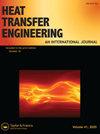Experimental Study on Indirect Liquid Cooling Performance of Metal 3D-Printed Cold Plates for Battery Thermal Management
IF 1.6
4区 工程技术
Q3 ENGINEERING, MECHANICAL
引用次数: 0
Abstract
AbstractTwo new cold plates manufactured via metal 3D printing were experimentally investigated for thermal performance analysis in indirect liquid cooling operations; then they were compared to the traditional cold plates. Experiments were performed with different coolant inlet temperatures (15.7 °C and 24.5 °C) and ambient air velocities (0.5 m/s and 3 m/s) at tropical conditions; hereby, the impact of high dew point temperatures at tropics was also investigated. Body-centered cubic (BCC) and pillar elements were applied in the cooling cavity of the cold plates. The results showed that the target surface temperature in both BCC- and pillar-filled plate designs was maintained below the limits at the lower inlet temperature. However, at the higher inlet temperature, the temperature was only maintained below the limit when the ambient air velocity was 3 m/s. The convective heat transfer coefficient at the inlet temperature of 15.7 °C was found 1.5 and 2.5 times higher than the convective heat transfer coefficient value at the inlet temperature of 24.5 °C for the pillar- and BCC-filled plates, respectively. The performance evaluation criterion values were found in the range of 1.2 − 2.4, which depended on the operating conditions and were already higher than the referenced studies in the literature. Disclosure statementNo potential conflict of interest was reported by the authors.Additional informationFundingThis study is funded by the Ministry of Education Tier 1 RG154/19 (Singapore) and the Unfettered Research Grant of the Momental Foundation (USA). B.B. Kanbur was the Mistletoe Research Fellow (2020–2021) and sincerely thanks the Momental Foundation for this opportunity during the tough research period in pandemics. We greatly appreciate Mr. Lim Si Xian for his help to measure the surface roughness of the cold plate. The authors would also like to thank the support of the Energy Systems Lab in the School of Mechanical and Aerospace Engineering at Nanyang Technological University (Singapore), the Thermal Energy Section in the Department of Mechanical Engineering at the Technical University of Denmark (Denmark), and the Singapore Centre for 3D Printing (SC3DP) at Nanyang Technological University (Singapore). Notes on contributorsBaris Burak KanburBaris Burak Kanbur is a postdoctoral researcher at the Technical University of Denmark. His main research interest is thermal engineering applications at lab-, component-, or system-level with the aspects of heat transfer and thermodynamics by using experimental and computational methods. He worked as a research fellow at Nanyang Technological University until 2022 after receiving his Ph.D. degree from the same university in mid-2019.Yi ZhouYi Zhou is a research associate in Singapore Center for 3D Printing at Nanyang Technological University. He received his B.Eng. from University of Electronic Science and Technology of China before receiving M.Sc. and Ph.D. degrees from Nanyang Technological University. His research interests include design of lightweight heat exchangers and metal additive manufacturing of complex shaped industrial structures.Mun Hoe SeatMun Hoe Seat is a naval warfare system engineer at the Republic of Singapore Navy. He received his mechanical engineering degree from Nanyang Technological University in 2022. His research interest is thermal management of power sources with lab- and component-scale experiments.Wiebke Brix MarkussenWiebke Brix Markussen is a senior consultant in the Center of Refrigeration and Heat pump Technology at the Danish Technological Institute. Her main research focus is cooling systems, refrigeration applications, and heat pumps with a strong expertise is thermodynamics and heat transfer. Previously, she was an Associate Professor at the Technical University of Denmark. She received her Ph.D. degree from the same university in 2010.Martin Ryhl KærnMartin Ryhl Kærn is a specialist engineer in Thermodynamics and Energy Technology at IPU. His research focus is fundamental and applied heat transfer focusing on heat exchangers, cooling systems, and refrigeration processes. He was previously a Senior Researcher at the Technical University of Denmark. He received his Ph.D. degree from the same university in 2011.Fei DuanFei Duan is currently an Associate Professor at Nanyang Technological University in Singapore. He joined the School of Mechanical and Aerospace Engineering at Nanyang Technological University in 2008. Before that, he was a postdoctoral fellow and Ph.D. student in University of Toronto, Canada. His research covers fundamental and applied studies on thermofluid and energy systems.金属3d打印电池热管理冷板间接液冷性能实验研究
摘要采用金属3D打印技术制备了两种新型冷板,对其在间接液冷工况下的热性能进行了实验研究;然后将它们与传统的冷板进行比较。实验在不同的冷却剂进口温度(15.7°C和24.5°C)和环境风速(0.5 m/s和3 m/s)下进行;在此基础上,研究了热带地区高露点温度的影响。在冷板的冷却腔中采用了体心立方单元和柱单元。结果表明,在较低的进口温度下,BCC填充板和柱填充板的目标表面温度都保持在限值以下。然而,在较高的进口温度下,只有当环境空气速度为3 m/s时,温度才能保持在极限以下。柱填充板和bcc填充板在进口温度为15.7℃时的对流换热系数分别是进口温度为24.5℃时的1.5倍和2.5倍。性能评价标准值在1.2 ~ 2.4之间,这取决于运行条件,已经高于文献参考研究。披露声明作者未报告潜在的利益冲突。本研究由教育部一级RG154/19(新加坡)和mental Foundation(美国)的无限制研究补助金资助。B.B. Kanbur是槲寄生研究员(2020-2021),他衷心感谢心理基金会在流行病研究艰难时期提供的机会。我们非常感谢林思贤先生对测量冷板表面粗糙度的帮助。作者还要感谢新加坡南洋理工大学机械与航空航天工程学院能源系统实验室、丹麦技术大学机械工程系热能科和新加坡南洋理工大学3D打印中心(SC3DP)的支持。作者简介baris Burak Kanbur是丹麦技术大学的博士后研究员。他的主要研究兴趣是通过实验和计算方法在实验室,组件或系统级的热工程应用,包括传热和热力学方面。2019年年中获得南洋理工大学博士学位后,他一直在南洋理工大学担任研究员,直到2022年。周毅是南洋理工大学新加坡3D打印中心的研究助理。他毕业于中国电子科技大学,获工学学士学位,毕业于南洋理工大学,获理学硕士和博士学位。他的研究方向包括轻量化换热器设计和复杂形状工业结构的金属增材制造。Mun Hoe Seat是新加坡共和国海军的海战系统工程师。他于2022年获得南洋理工大学机械工程学位。他的研究兴趣是实验室和元件规模实验电源的热管理。Wiebke Brix Markussen是丹麦技术研究所制冷和热泵技术中心的高级顾问。她的主要研究方向是冷却系统、制冷应用和热泵,在热力学和传热方面具有很强的专业知识。此前,她是丹麦技术大学的副教授。她于2010年在同一所大学获得博士学位。Martin Ryhl Kærn是IPU热力学和能源技术的专家工程师。他的研究方向是基础传热和应用传热,主要集中在热交换器、冷却系统和制冷过程。他之前是丹麦技术大学的高级研究员。2011年在同一所大学获得博士学位。段飞,现任新加坡南洋理工大学副教授。2008年加入南洋理工大学机械与航空航天工程学院。在此之前,他是加拿大多伦多大学博士后、博士生。他的研究包括热流体和能量系统的基础和应用研究。
本文章由计算机程序翻译,如有差异,请以英文原文为准。
求助全文
约1分钟内获得全文
求助全文
来源期刊

Heat Transfer Engineering
工程技术-工程:机械
CiteScore
4.50
自引率
17.40%
发文量
111
审稿时长
7.5 months
期刊介绍:
Publishing 18 issues per year, Heat Transfer Engineering is an unparalleled resource for key advances in the field of heat transfer for the practicing engineer and other workers in the field. The journal publishes analytical, numerical, and experimental articles of lasting interest in the general area of heat-mass transfer and the related fluid mechanics and thermodynamics.
In a clear, easy-to-read format, the journal includes refereed papers of original work, state-of-the-art reviews, articles on new developments in equipment or practices, reviews of fundamentals, heat in history articles, book reviews, news items on people and companies in the field, advertising, and any other items that may be appropriate.
All submitted manuscripts are subject to initial appraisal by the Editor and/or selected members of the Editorial Board, and, if found suitable for further consideration, to peer review by independent, anonymous expert referees.
 求助内容:
求助内容: 应助结果提醒方式:
应助结果提醒方式:


